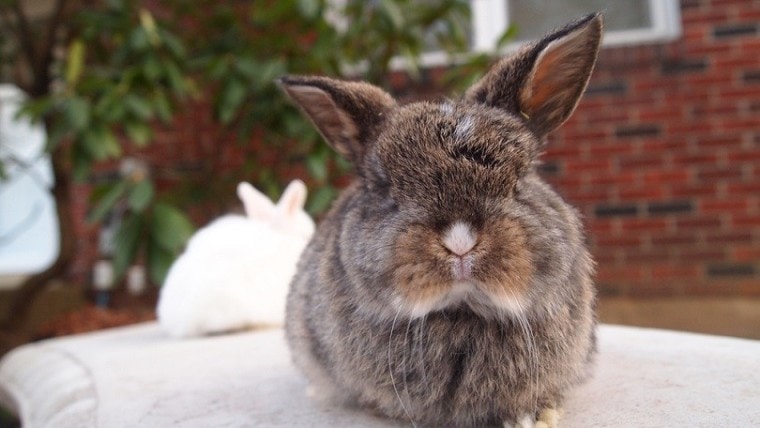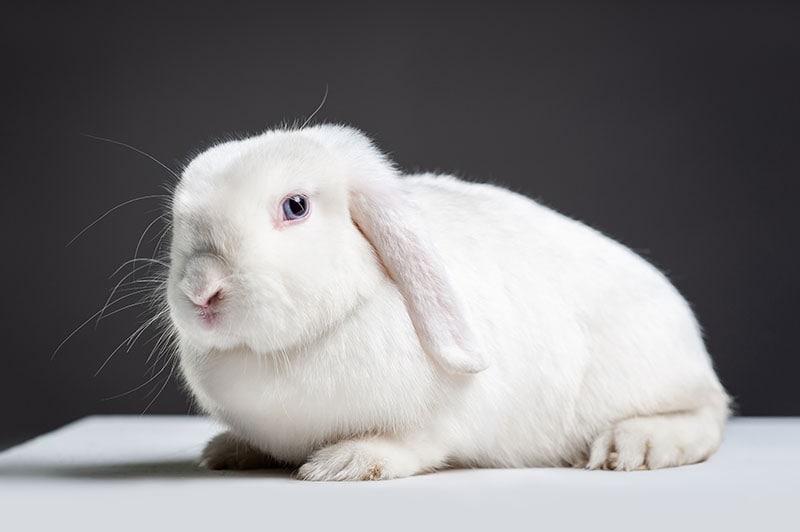
Click to Skip Ahead
The distinguishing feature of the German Lop Rabbit and others of their kind is their floppy ears. There are 17 recognized lop-ear rabbits of the 305 breeds worldwide. While the American Rabbit Breeders Association doesn’t list the German Lop Rabbit, the British Rabbit Council (BRC) acknowledges them and has an official standard for showing them.
The German Lop Rabbit is a relatively new breed, developed in the 1960s in the country that gives them their name. There are also variations from France, the United Kingdom, and the United States. Our guide will cover everything that you need to know about this adorable bunny.
Quick Facts about German Lop Rabbit
| Species Name: | Oryctolagus cuniculus domesticus |
| Family: | Leporidae |
| Care Level: | Easy |
| Colors: | All recognized colors, including the butterfly pattern |
| Lifespan: | 8 – 12 years |
| Size: | 6.5 – 8.5 lbs. |
| Diet: | Alfalfa or timothy hay |
| Minimum Cage Size: | 3’ L x 3’ W x 2’ H |
| Cage Set-Up: | Water bottle, food bowl, bed, and litter box |
| Compatibility: | Best kept singly or in pairs of a spayed female and neutered male |
German Lop Rabbit Overview

The German Lop Rabbit began life as a show animal. Their easy-going personality makes them a natural for the ring. It’s also what makes this bunny an ideal family pet. Like others of their kind, they are active at dusk and dawn. This rabbit enjoys the attention of their owner. They do best if they have daily exercise and interaction with their owner.
How Much Do German Lop Rabbits Cost?
The fact that the German Lop Rabbit is a show animal can have a significant impact on the price that you’ll pay for this pet. You can expect to pay about $50 or more, depending on their pedigree. An animal from a championship lineage will likely run well over $100. However, buying your new pet only scratches the surface of the actual cost of owning a bunny.
Your initial expenses will include housing. You should plan on buying a wire cage with a bed, water bottle, food bowl, and litter box. You can use an absorbent bedding material to keep your rabbit dry and reduce odors. You can figure on spending $200 or more to get started. After setting up your rabbit’s cage, annual costs will run at least $200.
We strongly urge you to find a veterinarian who specializes in rabbit care. Another expense that you should consider is spaying or neutering your pet if you don’t plan on breeding them. Your vet can advise you about the appropriate time. The surgery can run anywhere from $150-$400. We also recommend annual checkups. An office visit typically costs under $100.
Typical Behavior & Temperament
The German Lop Rabbit is a gentle animal with a sweet disposition. They are not a flighty bunny and will settle into a routine quickly. We recommend an hour or two of playtime every day. This is an excellent opportunity for your pet to stretch their legs and get exercise. It will also provide mental stimulation to keep them healthy on that score.
Your rabbit will enjoy being handled. However, remember that these animals prefer to be close to the ground. You can begin by sitting on the floor with your bunny and letting them explore their world. Bear in mind that rabbits are prey species in the wild. Some of these instincts are hard-wired into these animals even after decades of domestication.
Appearance & Varieties
The German Lop Rabbit is a medium-sized animal, weighing up to 8.5 lbs. They have a stocky build, which is part of the BRC’s standard for the breed. The standards also state that the neck shouldn’t be visible because of the muscular frame of this rabbit. Their ears are what give this bunny their name. The ears can be anywhere from 11 to 14 inches long.
You’ll find German Lop Rabbits in a broad spectrum of colors. Some popular variations are chinchilla, tortoise, black, and agouti. The butterfly pattern is also common. This is a marking that goes over the bridge of the bunny’s nose onto either side. It’s a fault in the show ring if this is broken and not the full butterfly shape. Likewise, white patches on a rabbit of any color also disqualify an animal.
How to Take Care of German Lop Rabbit
The essential thing to remember with the German Lop Rabbit and all bunnies is to avoid placing their cage in a drafty area. They can get upper respiratory infections, which can increase their risk of more serious conditions, such as pneumonia.

Habitat, Cage Conditions & Setup
The best cage for a rabbit is a wire one. This is easy to clean and ensures adequate circulation. A cage with a tray on the bottom will help keep the bedding inside the cage instead of the area around it. While we provided a minimum size, the bigger, the better. It will give your pet enough room to exercise if you choose not to take them out to play.
Bedding
We recommend using a bedding that is either paper or wood shavings. Choosing a recycled product will make it an eco-friendly choice. Plan on changing bedding daily to ensure that your rabbit’s living quarters are clean and dry. Many materials contain chemicals to reduce odors. We suggest steering away from scented bedding to avoid any allergic reactions.
Food and Water
You can put a small bowl in the cage for rabbit pellets when you offer them to your pet. You should also hang a water bottle inside the cage. We recommend getting a bottle with a reinforced bottom rim or opting for a glass one instead.
Like others of their kind, the German Lop Rabbit’s teeth continue to grow their entire life. Chewing hay will help keep them in check. However, they are likely to chew on anything else they can find.
Bed or Cover
Rabbits like to hide. It’s something that makes them feel more secure, especially if it’s enclosed, and your bunny can peer out of it. It will also help to keep your pet warm. You can find products made of foodstuffs, such as timothy hay, so you needn’t worry about your pet chewing on it.

Do German Lop Rabbits Get Along With Other Pets?
Your German Lop Rabbit probably won’t get along with your dog or cat, especially if either one has a strong prey drive. Of course, size is another concern, particularly with larger pets. Although rabbits are social creatures, they are also territorial animals. That’s one reason that we recommend keeping them alone or in pairs of neutered animals.
What to Feed Your German Lop Rabbit
The bulk of your German Lop Rabbit’s diet should come from hay. That will provide adequate fiber and keep your pet’s teeth a healthy length. You can offer commercial pellets occasionally as a treat. However, we suggest limiting other foods. Your bunny will be perfectly content with a steady diet of hay.
Keeping Your German Lop Rabbit Healthy
Rabbits are relatively healthy animals, as long as you meet their basic needs for food, water, and shelter. Drafts are one of the main concerns. A stress-free environment is also an excellent way to keep your bunny happy. Avoid blaring loud music or cranking up the TV in the room where you keep your pet.

Annual checkups are good for keeping your rabbit healthy. We suggest monitoring your pet’s behavior and feeding habits too. Often, an animal will stop eating or act strangely if they’re not feeling well. Other signs of problems include discharge from your bunny’s eyes or nose, GI distress, or lethargy.
Breeding
We don’t recommend breeding your German Lop Rabbit. The statistics on surrendered pets are sobering. Part of the reason is that individuals may fail to do their homework about what owning a bunny takes. There are expenses and rabbits require daily care. If you’d like to add a companion for your pet, please consider adopting a rescue animal instead.
Are German Lop Rabbits Suitable For You?
There’s no doubt that the German Lop Rabbit can make an excellent family pet. They are affectionate and docile animals that can make a delightful addition to your home and a wonderful companion for you and your children.
Featured Image Credit: Katie E Boyd, Shutterstock









